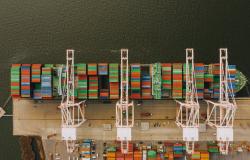We're approaching a new era of diversification in global trade: Here's why it matters

-
We’re seeing a monumental shift towards another new era, with trade and supply chains at the heart of these changes.
-
With this heightened focus on resiliency, we’re witnessing a new era of diversification with clear benefits for economic growth.
-
The new era of diversification offers a new way forward for globalization, not a reversal of course.
Citi CEO Jane Fraser addressed world leaders at the APEC CEO Summit in San Francisco in November 2023. She highlighted key trends in trade that she is seeing from her vantage point leading a global bank. The following article has been adapted from those original remarks.
As a bank with a more-than-200-year history, Citi has had a front-row seat to the evolution of globalization. Over the last several decades, there has been a strong emphasis on sourcing and moving manufactured goods as efficiently as possible to cut costs. However, the recent ongoing geopolitical and macroeconomic shocks have upended this approach.
As it stands today, we’re seeing a monumental shift towards another new era and trade and supply chains are at the heart of these changes. Simply put, we’re reaching a critical tipping point.
We see nearly every country and company focused on security, be it food, water, energy, cyber, financial or operational security. Consequently, they’re reconfiguring supply chains to meet the demands of their customers and other stakeholders. As we saw through the COVID-19 pandemic, concentrating the sourcing or production of any good, let alone essential goods, in one part of the world can have dire consequences.
Now, amidst the backdrop of transformative technological innovations, increasing resilience is the clear and resounding call. With this heightened focus on resiliency, we’re witnessing a new era of diversification with three clear benefits in economic growth beginning to emerge.
Opportunities for smaller players
First, as demand for resiliency and diversity grows, so does the opportunity for smaller players to engage in global trade, including last-mile suppliers in developing countries.
As I wrote in a previous post, supporting small and medium-sized enterprises (SMEs) is critical to building a more inclusive global economy and more resilient supply chains. At Citi, we’re playing an important role in bringing more SMEs into the fold.
In November 2023, for example, we announced a $100 million social finance loan for ICICI Bank in India to support more than 300,000 female entrepreneurs. This funding will be used to help women in rural India grow their small businesses and, in turn, increase their participation in global commerce.
More diversified economies
A second benefit is how investments in supply chains are creating diversified economies. Malaysia, Thailand and Vietnam are early examples of this in the Indo-Pacific. In the Middle East, Saudi Arabia, the UAE and others are undergoing their own transformations as they look to diversify from oil.
Countries and companies are also diversifying their supply chains in specific sectors. This is particularly evident in Mexico, where we’ve been supporting clients seeking to reduce risk and increase efficiencies through nearshoring.
In some cases, we see North American-based automakers bringing supply chains closer to home. In other cases, it’s European and Asian companies moving closer to their end consumers in North America. Last fall, for instance, Citi helped finance a Korean auto parts supplier as it opened a 500,000-square-foot plant in Guanajuato, Mexico.
The economic benefits are already rippling through the global economy as new factories and stores create jobs and economic value in the communities where they’re located. They also add value for the Asian, European and American companies who have built them, not to mention each of their home markets.
New trade corridors
The third benefit we’re seeing from diversification is the creation of new trade corridors. Brazil is trading more with India and China than it is with Argentina. The Middle East is now more connected to Asia than Europe, and those connections will be further strengthened by a proposed economic corridor connecting the Middle East to India.
Resilience does not mean retreating to our corners. In some sectors, national security requires us to increase domestic production capabilities. But excessive self-reliance in the name of national security won’t make us more secure. True resilience comes from open markets and robust and diversified supply chains, and a decoupling of the world’s dominant economies is neither possible nor prudent.
We are best served to focus on fostering intra- and inter-regional collaboration, as there is growing evidence that these relationships can produce significant benefits. Regional free trade agreements, such as the Regional Comprehensive Economic Partnership (RCEP) and the Comprehensive and Progressive Agreement for Trans-Pacific Partnership (CPTPP), are only a few years old, but they are already lowering tariffs, opening markets for services and protecting investment and intellectual property between major economies in the region. They’re also paving the way for cross-border collaboration with rules-of-origin provisions. More regional trade agreements with market access provisions can go a long way to open these various paths.
The new era of diversification offers a new way forward for globalization, not a reversing of course. We must not lose faith in the tools that have enabled growth and progress over these past decades. And we should be conscious of avoiding policies that swing the pendulum too far towards resilience and away from affordability and economic growth.
We ought to seek enhancements to both security and resilience through more global cooperation, not less.
Jane Fraser is the Chief Executive Officer of Citi, the world's most global bank, serving millions of consumers, businesses and institutions across 160 countries and jurisdictions. She is the first female CEO in the firm’s history.
Photo by Kelly
Republished from the Agenda blog under Creative Commons Attribution-NonCommercial-NoDerivatives 4.0


